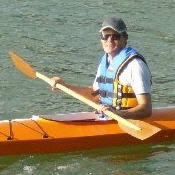I’ve determined enough to categorically state that she is not the scow that I first suspected. On my last visit to her mooring I took photos but made no attempt to gauge her dimensions. On this latest trip I manoeuvred my Dart carefully in the strong outgoing tidal current and judged her to be only 2.5 Darts long and not quite a Dart wide. In more conventional units, that’s a waterline length of around 35 feet and a beam of around 12 feet. This is roughly half the recorded size of the scow ‘VESPER’, and even allowing for the somewhat rudimentary means of measurement, I don’t think I could get it that wrong.
The need for heavy cargo boats of shoal draft comes from Auckland’s location. Situated on an isthmus the city is squeezed between the Manukau Harbour to the south, which opens into the Tasman Sea on the West coast, and the Waitemata Harbour to the north, which opens into the Hauraki Gulf to the East. As the population of the region grew and more of the land was settled, so resources such as timber for building and livestock to feed the city folk needed to be sourced in larger quantities and from further afield. Scows weren’t used exclusively in the Auckland region by any means, but for a while, they were the lifeline for this burgeoning community.
 The sailing scow 'VESPER', taken around the turn of the 19th to 20th Century
The sailing scow 'VESPER', taken around the turn of the 19th to 20th Century
Captain Biddick commissioned another vessel of similar design, this time 76’8” by 21’8” and built by Bailey and Lowe in 1902. She was called ‘VESPER’. The picture from Anthony Flude’s site on Auckland history show a far more refined shape than the smaller ‘TED ASHBY’, a reproduction of an earlier design with the more modest dimensions of 57’ by 18’. It was the refined lines in this picture that gave me hope that the ‘VESPER’ I had seen was the same boat, but the dimensions rule that out. Incidentally, the scow VESPER’ was last recorded as being used as a mussel barge in the Marlborough Sounds in 1992 according to Mike Subritzky’s book ‘Subritzky Shipping’.
 The 'TED ASHBY' at the National Maritime Museum, Auckland
The 'TED ASHBY' at the National Maritime Museum, Auckland
So I still don’t know the origins of the flat bottomed, gaff rigged schooner ‘VESPER’ that is moored in the Upper Waitemata Harbour. I’ll send my photos off to the National Maritime Museum and see if model maker and scow enthusiast I was talking to has any clues...
References
Papers Past - The Auckland Star, 29th January 1884
The Days of the Sailing Scows by Anthony G. Flude
NZ Scows from Mike Subritzky's 'Subritzky Shipping' compiled by Koeke Junction




No comments:
Post a Comment